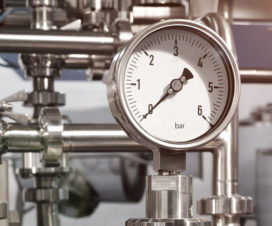Download the full video transcript here.
Getting the right pressure relief valve is essential to protect your process, your personnel, and your facility. Here we identify the piece of information you need to specify a safety valve, safety relief valve, or relief valve — plus some “bonus” details that will make the selection process a breeze.
Before you begin
First things first, are you replacing an existing valve? If the answer is “yes,” chances are you already have all of the information required.
Each valve comes with a nameplate from which you can pull much of the information you need, like the manufacturer name, model number, set pressure, size, code stamp, service, and capacity. If you have this information — especially the model number — you may be all set.
Core requirements for valve selection
If you’re building out a new process or don’t have access to an existing valve’s data, you’ll need to determine these critical pieces of information to specify your correct pressure relief valve.
Quantity
How many pressure relief valves does your system require?
Inlet and outlet size and type
Your valve needs to correspond to the size of your inlet and outlet piping. According to The National Board of Boiler and Pressure Valve Inspectors, your inlet and discharge piping can’t be smaller in diameter than the valve inlet and outlet openings. Incorrect sizing can interfere with normal device operation. The inlet size and connection of your valve will range depending on your application.
You also need to determine if the valve connection should be flanged or threaded (male or female).
Construction material: Trim and bonnet
Trim is the material the seating surfaces are made of. There are many options to choose from, including bronze, stainless steel, steel, iron, and other different types of alloys.
Bronze and stainless steel are standard trim materials, but what you select depends on your process. For example, if you’re working with petroleum, your trim might require an exotic alloy material. Or if your service is something corrosive like hydrochloric acid, your seating material will need to be made from a higher-grade metal.
Much like trim, the bonnet material — or body material — will depend on your service. Again, there are many bonnet materials to select from, including bronze, stainless steel, or specialty alloys like Monel.
Service
Service determines the type of valve you need, the valve material, and more.
When you define your service, you may have to be more specific than “steam,” “air,” or “gas.” There are thousands of services used in industrial processes, encompassing everything from molasses to water to hydrogen to ethylene glycol, and each one has a unique set of valve requirements.
In order to select the correct valve, you may need to provide extra info about your process fluid:
- Molecular weight
- Specific gravity
- Viscosity
- Ratio of specific heats
- Compressibility factor
- Process temperature
Also include any standards or codes that apply to your service.
Set pressure
Set pressure is a piece of information that’s absolutely required to specify a safety or pressure relief valve.
Measured in pounds per square inch gauge (PSIG), set pressure is the point at which the pressure relief valve opens. The set pressure of your valve should never exceed the MAWP (maximum allowable working pressure) of the equipment the valve will be placed on. Further, it’s recommended that your maximum operating pressure be 10% below your valve’s set pressure.
Set pressure for liquid service
Defining the set pressure for liquid service can be tricky, as liquid relief valves are susceptible to chatter — the rapid opening and closing of the valve.
Repeated opening and closing can result in things like misalignment, valves seat damage, and even mechanical failure, making chatter a significant safety risk. To avoid these issues, place your liquid set pressure at the pressure when the first heavy flow — or first steady vertical flow — occurs.
Unusual conditions, if any
Pressure relief valves will operate differently based on the environment. So if you’re going to install your valve somewhere with extremely high or low temperatures, define that too. Here are a couple examples of how the environment can affect valve operation:
- High ambient temperatures can affect the set pressure of the valve
- Low ambient temperatures combined with moisture can make valves freeze, causing vibration and possible malfunction
Further, make sure to employ capacity correctors for superheated steam, liquid overpressure, air-gas temperature, and density correction if necessary.
Other information to consider
The information above is required to know prior to purchasing a valve. Having these further snippets of information is optional, but will help guarantee you get the best valve for your application.
Required capacity
Relief valves have to be able to relieve pressure at a certain capacity. If a valve can’t meet or exceed your required capacity, you can end up with major issues.
These are some of the factors that determine the relief capacity for a valve:
- Valve geometry
- Media temperature
- The relief discharge area
- Other sources of heat input
- Pumps that may increase pressure
The metric for required capacity depends on your service:
- LBS/HR – pounds per hour (steam service)
- SCFM – standard cubic feet per minute (air or gas service)
- GPM – gallons per minute (liquid service)
When you’re working on this determination, refer to The ASME Boiler and Pressure Vessel Code and American Petroleum Institute Recommended Practices.
Orifice size
Orifice size and inlet size go hand in hand. The smaller inlet size, the smaller the orifice size.
For example, if you have a ½” inlet size, you’ll need a D orifice — the smallest opening you can get for that inlet size.
Operating pressure
Identifying the pressure at which the valve will be subjected to regularly — or the operating pressure — will ensure you select a valve that can withstand your standard operating conditions.
Operating and relieving temperature
Knowing your operating and relieving temperatures will help you ensure the valve you select will stand up to everyday use.
Operating temperature can affect the volume and viscosity of a gas or liquid flowing through the pipes. Further, the operating and relieving temperatures can help determine the best material for your application. For example, if you need a pressure relief valve for a steam process and you know the steam is hotter than usual when the pressure relief valve is triggered, you’ll need to select a valve that can handle those higher temperatures. In this case, you might choose a steel valve instead of bronze or iron.
Allowable overpressure
Your allowable overpressure helps determine the valve’s code stamp. The allowable overpressure typically depends on where you’re using the valve.
There are three options for allowable overpressure — 3%, 10%, and 21%.
You can generally figure out your allowable overpressure by determining your application and if the valve will ever see a fire.
- 3% — valve is on a boiler for a steam service
- 10% — valve isn’t directly on a boiler, but instead on an unfired vessel or piping system
- 21% — valve might see a fire
Maximum allowable seat leakage
Each Kunkle valve comes with its own leakage acceptance criteria, so knowing this piece of information will help make proper seating selection. For example, if you can’t allow any leakage at all, you must select a valve with soft seating.
ASME Boiler and Pressure Vessel Code (BPVC)
Manufacturers build pressure and safety relief valves per one of two ASME codes: Section I or Section VIII.
- Section I covers fired pressure vessels, usually a boiler
- Section VIII covers unfired pressure vessels, or anything that isn’t a boiler
Accessories
Valves are compatible with different kinds of accessories — too many to mention here — designed to make your operations run safely and efficiently. Keep in mind that certain codes may dictate which options you can choose.
Here are a few examples:
- Vibration dampeners
- Lifting levers
- Soft seats
- Pressure tight caps
If you give our valve experts some details about your process, we can suggest appropriate accessories that will be a good fit for your application.
—
Coming armed with more details about what you need will expedite the valve selection and purchasing process. However, you don’t need to wait to gather all the details provided here before starting. If you provide these three basic pieces of information, we can help guide you in the right direction:
- Set pressure
- Service
- Inlet size
And of course, knowing what trim and bonnet material you need is a good bonus!
Given these pieces of information, we can give you a starting point for selecting the perfect valve for your application. Contact us today to get started!




